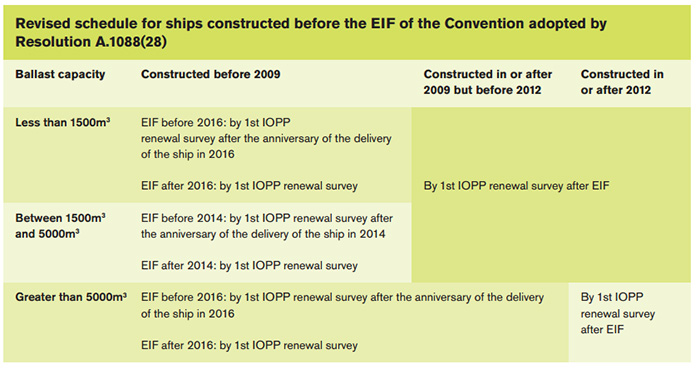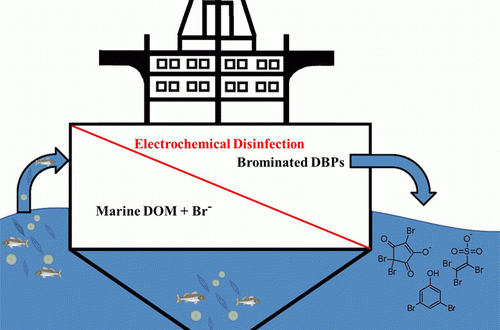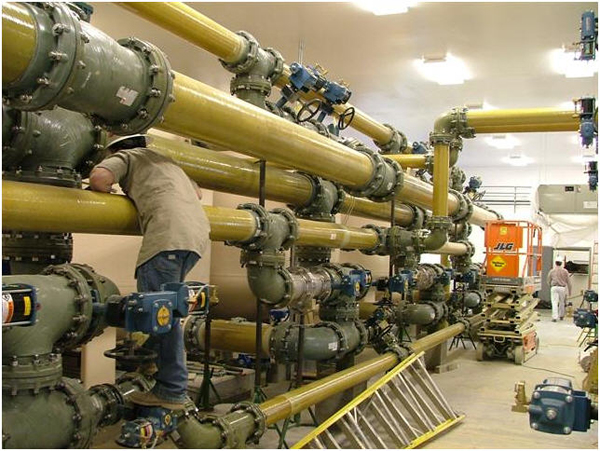PEARL is a specialist in both retrofit systems and we offer full package service. We made inspection on side, prepare technical solution and off course installation. Installation of BWTS and SWCS requires a presurvey before any installation activities are started. We can offer removing existing pipes and installing new system from GRE pipes. All activities are connected with logistic and off course fast installing.
IMO in 2004 adopted an international convention for control and management of ships ballast water and sediments. The requirements apply to all new vessels build from 2012 onwards and they apply to older vessels as well. From 2014 vessels with ballast water tank capacities of 1500 to 5000m3, leading to a total ban on the transfer of harmful organisms from 2016.

The shipping industry has supported efforts to address aquatic invasive species, but before it spends as much as $60 billion installing new ballast water treatment technology, a legal regime that offers greater clarity, predictability, and investment certainty is required, argues the World Shipping Council.
Estimates used at the IMO have projected that that there are roughly 62,000 vessels that will need to install treatment technology under the IMO Convention once it enters into force. If one assumes that the technology may cost $1 million to $2 million per ship, a capital investment of well over $60 billion will be required.
There are two principal legal regimes governing this issue. One is the IMO Ballast Water Management Convention, which will enter into force one year after ratifications by 30 or more member states that surpass 35% of the world’s merchant tonnage. Currently, the number of ratifications stands at 44 countries, representing 32.9% of the world’s tonnage. In short, it will not take much in the way of additional ratifications for the Convention to enter into force.
The second is US law, which has important similarities and important differences from the IMO Convention. The US regime has adopted the IMO Convention’s ballast water discharge treatment standard (the “D-2” standard), which confirms a uniform international regulatory objective, but insists on equipment type approval guidelines that are more rigorous that the currently inadequate IMO-type approval guidelines.
What a ship operating in international commerce needs is a uniform approach to vessel discharge requirements and to the equipment needed to meet those requirements. But, there is no globally accepted ballast water treatment technology. The IMO’s equipment type approval guidelines remain inadequate and have not been remedied, and no technology vendor has yet met, or even applied to be approved under, US equipment type approval guidelines.

Untreated ballast water discharge from ships can spread living organisms and even pathogens across the world thereby introducing non-native or invasive species into the local environment.
Scientists at Helmholtz Zentrum München therefore recommend using physical treatment processes such as filtration rather than electrochemical disinfection, which creates countless potentially toxic compounds. These are the findings of a recent study published in the journal Environmental Science and Technology.
In order to prevent the transfer of harmful organisms, ships’ ballast water is often subjected to electrochemical disinfection. “However, our analyses show that electrochemical disinfection creates numerous so-called disinfection by-products (DBPs),” explains Prof. Philippe Schmitt-Kopplin, who led the study. He and his team at the Analytical BioGeoChemistry (BGC) research unit at the Helmholtz Zentrum München, working in close collaboration with colleagues in the US, compared samples of treated and untreated ballast water.
The Merchant Shipping Directorate of Malta issued a Technical Notice to draw the attention of all concerned to the designation of areas for ballast water exchange in the North Sea in accordance with regulation B-4.2 of the Ballast Water Management Convention by Belgium, Denmark, France, Germany, Norway, the Netherlands, Sweden and the United Kingdom.
Regulation B-4.2 of the Convention allows ports States to designate areas, in consultation with adjacent or other States, as appropriate, where ships may conduct ballast water exchange. Regulation B-4.2 determines that such sea areas can be designated in sea areas where the distance from the nearest land or the depth does not meet the parameters described in paragraph 1.1 or 1.2 of the regulation.
Furthermore Norway has implemented parts of the Ballast Water Management Convention (Regulation D-1; the exchange standard) in its national regulations which entered into force on 1 July 2010. Three exchange areas have been designated within Norway´s exclusive economic zone (EEZ).
To this end a ship, on a voyage between 2 ports located in the North Sea, which under the Convention shall at least meet the standard described in regulation D-1, may conduct ballast water exchange in the designated ballast water exchange area in the North Sea. A ship conducting ballast water exchange in this area shall comply with all the regulations for ballast water exchange in the Convention, with the exception of regulation B-4.1.
The ballast water exchange areas have been identified assessed and designated taking into account the relevant the “Guidelines on Designation of Areas for Ballast Water Exchange (G14)” and the precise geographical co-ordinates of the areas may be found in BWM.2/Circ.56

The explosion-proof version of Alfa Laval’s chemical-free ballast water treatment system, PureBallast 3.1 EX, has received approval from the U.S. Coast Guard for use on barges sailing in U.S. coastal waters.
The approval comes a year after Alfa Laval PureBallast received an IECEx Certificate of Conformity from the International Electrotechnical Commission (IEC) for use in explosive atmospheres on board ships in international waters.
